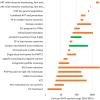The case for investing in the male condom
- PMID: 28510591
- PMCID: PMC5433691
- DOI: 10.1371/journal.pone.0177108
The case for investing in the male condom
Abstract
When used correctly and consistently, the male condom offers triple protection from unintended pregnancy and the transmission of sexually transmitted infections (STIs) and human immunodeficiency virus (HIV). However, with health funding levels stagnant or falling, it is important to understand the cost and health impact associated with prevention technologies. This study is one of the first to attempt to quantify the cost and combined health impact of condom use, as a means to prevent unwanted pregnancy and to prevent transmission of STIs including HIV. This paper describes the analysis to make the case for investment in the male condom, including the cost, impact and cost-effectiveness by three scenarios (low in which 2015 condom use levels are maintained; medium in which condom use trends are used to predict condom use from 2016-2030; and high in which condom use is scaled up, as part of a package of contraceptives, to meet all unmet need for family planning by 2030 and to 90% for HIV and STI prevention by 2016) for 81 countries from 2015-2030. An annual gap between current and desired use of 10.9 billion condoms was identified (4.6 billion for family planning and 6.3 billion for HIV and STIs). Under a high scenario that completely reduces that gap between current and desired use of 10.9 billion condoms, we found that by 2030 countries could avert 240 million DALYs. The additional cost in the 81 countries through 2030 under the medium scenario is $1.9 billion, and $27.5 billion under the high scenario. Through 2030, the cost-effectiveness ratios are $304 per DALY averted for the medium and $115 per DALY averted for the high scenario. Under the three scenarios described above, our analysis demonstrates the cost-effectiveness of the male condom in preventing unintended pregnancy and HIV and STI new infections. Policy makers should increase budgets for condom programming to increase the health return on investment of scarce resources.
Conflict of interest statement
Figures
References
-
- UNAIDS. Meeting Report: Data for Fast-Tracking Condom Programmes. Global Condom Steering Group, Geneva, March 2016.
-
- Trussell J. Contraceptive Efficacy In: Hatcher RA, Trussell J, Nelson AL, Cates W, Kowal D, Policar M. Contraceptive Technology: Twentieth Revised Edition. New York NY: Ardent Media, 2011. Table 3–2.
-
- Ghys PD, Diallo MO, Ettiègne-Traoré V, Kalé K, Tawil O, Caraël M, et al. Increase in condom use and decline in HIV and sexually transmitted diseases among female sex workers in Abidjan, Cote d’Ivoire, 1991–1998. AIDS, 2002;16(2):251–258. - PubMed
MeSH terms
LinkOut - more resources
Full Text Sources
Other Literature Sources
Miscellaneous



